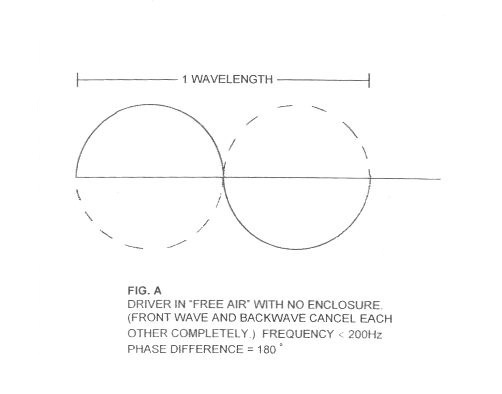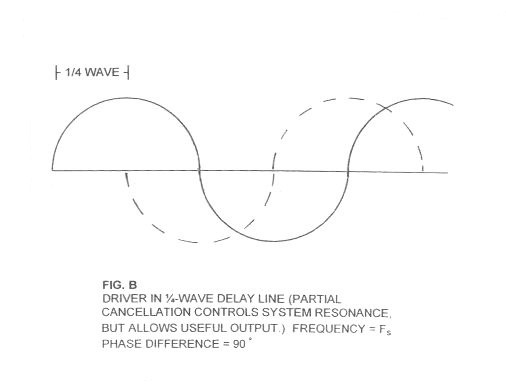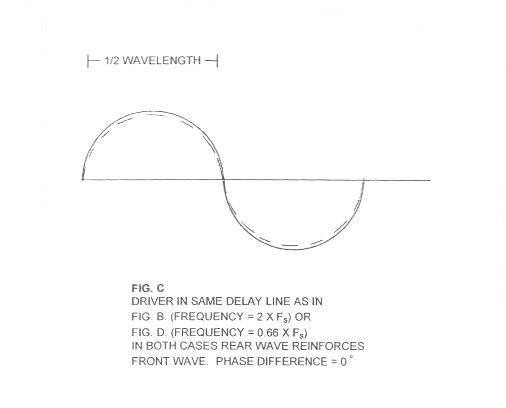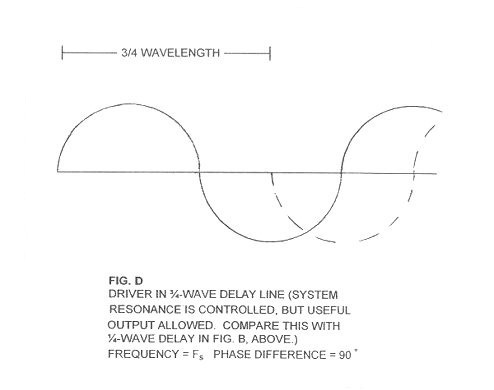IKONOKLAST Speaker Systems
TECHNICAL INFORMATION
WE HAVE COMPLETELY ELIMINATED THE CROSSOVER NETWORK
Until very recently, speaker system designers seemed to be trying to one-up each other by adding ever greater numbers of capacitors, inductors and resistors to their crossover networks. High order filters with steep slopes and extra bandpass filters to "iron-flat" minor amplitude variations were all the rage.
Now, many serious enthusiasts have discovered that different type capacitors vary substantially as to sound quality. The most astute have recognized that all capacitors sound bad, but since they are necessary in some audio circuit functions, one should attempt to select the least of evils. This new found realization seems to have caused back-peddling on the part of speaker designers who now appear to be returning to more basic designs. We applaud this trend, but think it should conclude, logically, with elimination of all capacitors, wherever possible. In the IKONOKLAST systems, we have been successful in eliminating all capacitors, period. We believe this is a foundation for their sonic success.
Similarly, today’s strong focus on quality speaker connecting cables has lead many to question the desirability of adding a long spool of copper wire (inductor) in series with loudspeaker drivers. We believe inductors also are sonically undesirable. In our speaker design projects over the past 30 years, we have observed that they all sounded better when any inductors were removed. Fortunately, we have been able to eliminate completely the need for inductors in the IKONOKLAST systems by using purely acoustic filtering techniques.
Since we are keenly aware that wires and connectors do have characteristic sound quality, we have chosen the finest sounding internal wiring and terminal hardware. Input terminals are rhodium and silver plated brass, with gold plated nuts. Both drivers are field-replaceable using high-pressure, pure silver to pure silver crimp connections.
WE HAVE ELIMINATED THE WOOFER
High moving mass in a driver is the enemy of fast transient response, because it takes longer for a heavier object to accelerate and decelerate. Designers of conventional speaker systems are forced to use woofers with high moving mass, because the sealed or ported enclosures they tend to favor raise the free-air resonance frequency of any driver they choose to install. This is an inevitable result of the air trapped inside the box adding effective stiffness to the driver’s suspension, which always must raise the resonance frequency. The only refuge for these designers is to select a woofer with so heavy a moving system, that even when placed inside their box, the resonance will still be low enough for the system to cover the lowest frequencies desired. The transient response of their systems therefore suffers, as a result of this high moving mass.
But, the acoustic transmission line does not greatly stiffen the air behind the driver, and therefore does not raise the resonance frequency significantly. So, the designer can employ a lower mass woofer than would be possible in a sealed or ported system, with identical low-end cutoff frequency. Transient response is therefore improved. The traditional ¼-wave tuned acoustic delay line also provides "selective damping" of the system’s main resonance - inhibiting cone motion at the resonance frequency, only, leaving the radiator completely uninhibited at other frequencies. Simultaneously, the line output reinforces driver output, over a wide band of frequencies, centering on twice the resonance frequency. More on this subject, later.
IKONOKLAST 3 and 5 ratchet up the acoustic transmission line advantage to new heights with their "triple length" ¾-wave alignment. This places its bass reinforcement mode below the resonance frequency of the driver (instead of above it, as in traditional transmission lines). A driver which is optimized for midrange reproduction, with a minuscule moving mass, may thus be operated down into "woofer territory" - all the way down into the lowest octave. Hearing these mid range drivers reproducing deep bass is a gratifying experience- the speed and detail can be jaw-dropping!
ONLY 5 TO 70 WATTS RECOMMENDED AMPLIFIER POWER
When an ultra low mass driver with a powerful magnetic circuit is operated in a low-back pressure acoustic transmission line, without power draining crossover components, good things happen to sensitivity. Typical room performance of Ikonoklast systems is 91 to 95dB/2.83V/m.
These good sensitivity figures do not tell all, however. The high quality of the drivers, direct ("crossover-less") connection to the amplifier, and the free-flow transmission line enclosure allow IKONOKLAST to sound clear and enjoyable when producing lower sound pressure levels than other systems. As long as the listening environment is quiet, one can listen at a much lower volume than is customary, and still feel satisfied. This has important implications for apartment dwellers and people who do not wish to disturb other members of their household, while enjoying a sublime listening experience.
The excellent downward dynamic range also implies that there is virtually no lower limit to usable amplifier power (The late "Gizmo" Rosenberg reported good results using a 1-watt SETamp). Just avoid HVAC fans, and other extraneous noise. Late nights and wee hours are usually best, using "micro-power," and the higher the quality of the input signal, the more viable the result.
COHERENT LINE SOURCE, BENDING WAVE, 360º TWEETER
The basic mechanism used in our exclusive tweeter was patented over 20 years ago by the late Lincoln Walsh who described larger, more massive voice-coil driven units for nearly full-range reproduction of the sonic spectrum.
The vertically positioned radiating "cone" of this device is configured so that "piston action" is inhibited and/or absorbed. Instead, longitudinal waves (also known as bending waves) are facilitated, starting at the apex, and rippling through the material until they are launched into the surrounding air, sideways, spreading from the driver like waves in a pond, when a pebble is tossed-in.
When the geometry, materials and construction methods are correct, all frequencies remain in perfect phase relationship, as they arrive at the listener’s ears. The coherent line source is said to approximate closely the ideal "pulsating sphere."
Earlier implementations of this technology have attempted to cover too wide a frequency range to permit state-of-the-art reproduction of the higher frequencies. The mass of the moving system was simply too great for the best high frequency transient response, and output did not continue into the ultrasonic region.
We believe our all new ultra low mass, piezoelectric-driven coherent line source used in IKONOKLAST systems is the only effectively high frequency-optimized realization of this technology ever to be offered commercially. The membranes are crafted from a specific aluminum alloy, only five ten thousandths of an inch thick. Total moving mass is less than one twenty-fifth that of the finest voice coil-type dome tweeters. Its dynamic and open sounding upper midrange through ultrasonic high end may be second to none in sonic quality and musical realism, regardless of price.
Some question the necessity or desirability of extending response into the ultrasonic region- "people cannot hear that high," they say. But ultrasonic response serves as a useful marker for superior transient response, at audible frequencies. Also, overlooked is the fact that when music is played live, different musical notes mix with each other to produce sum and difference frequencies. Although most humans cannot hear frequencies above 20kHz, what if the music has simultaneous 25kHz and 30kHz content? In this case, a difference frequency of 5kHz would be generated. Few people would dispute that 5kHz can be heard! This phenomenon is frequently sited to explain why listeners have been demonstrated to observe when ultrasonic frequencies have been filtered from reproduced music. Normally reported is that the music sounds more "closed-in" and less "airy" when ultrasonic content is missing. The fact that this superlative reproducer is connected directly to the amplifier with no intervening capacitor (unlike magnetic or electrostatic tweeters) also makes an important contribution to its obvious audible superiority.
Mid/LF DRIVER MANUFACTURED TO HIGHEST STANDARDS
It is interesting to observe, that the mid/LF driver’s requirements are precisely the reverse of the tweeter, in this important respect- while bending (longitudinal) waves are encouraged and piston-action inhibited in the tweeter, the mid/LF driver, instead, must behave as a near-perfect piston, without any tendency to propagate bending waves. Bending waves which originate spuriously on piston-driver cones are of random phase relationship with the desired piston-generated waves. Uncontrolled phase is unacceptable for a system which aspires to reproduce a coherent wave front which can accurately re-create a live musical event.
The above considerations have led us to reject some gorgeous looking aluminum cone material. Pity. It would have been a perfect visual match for the tweeters. But, we know from our tweeter design experience that aluminum can be just a little too good at propagating bending waves!
Instead, we have selected HDA (High Definition Aerogel)and mineral-filled polypropylene membranes that exhibit almost perfect high frequency rolloff, without he troublesome pre-rolloff rise in response that is characteristic of nearly all other similar drivers. This smooth roll off is a big advantage in this system which uses no electrical crossover components, whatsoever. The total moving mass of the mid/LF driver is only about 7 grams.
These advanced cone materials, along with the non-resonant die cast frames produce sensitive, phase coherent piston drivers. We have successfully integrated these featherweight reproducers with our coherent line source tweeters, producing two-way systems which eloquently speaketh with but one voice!
A sealed or ported cabinet would be the obvious choice. Why buck prevailing trends? We rejected the usual sealed or ported enclosure for the following reasons:
Using our ultra low-mass midrange driver in a sealed or ported system would have resulted in a low-frequency cutoff of around 80Hz. Not exactly a full range system!
Transient response would have been degraded due to loss of the frequency selective damping ability of the transmission line output.
Liveliness of the sound and sensitivity would have diminished because of the need for the driver to struggle against the stiff cushion of air trapped inside the box.
As a practical matter, we would have needed to specify a different driver with typical "woofer parameters" (i.e. high mass moving system) to achieve similar, nearly full range bass reproduction. The mids would have been broadly inferior and the bass transients would have been comparatively sluggish.
The IKONOKLAST acoustic transmission line sounds better than a box because it doesn’t trap air behind the driver’s cone, thereby inhibiting its motion at all frequencies. It only inhibits motion of the cone at the one frequency where it is needed- the resonance frequency of the driver(Fs). This is accomplished by delaying the back wave from the driver the precise length of time required to cause the front wave and back wave to mix in the room, in a "partially out of phase condition"- traditionally, and in Ikonoklast7, a one fourth wavelength delay is used. This same delay represents one half wavelength at 2 X Fs. The half-wave resonant mode is very broad (covers a wide band of frequencies) and is in phase with the front wave, so it contributes desirable useful output to the system, with the potential to virtually double the bass output of a small driver.
The IKONOKLAST3 and IKONOKLAST5 transmission lines represent a further enhancement to the traditional type described above. Instead of setting the delay line length to ¼-wave, it uses a "triple length" ¾-wave alignment. The drawings show that the ¾-wave delay produces the same phase difference (90o) as the ¼-wave delay, but interacting with the second half of the Hertz (cycle), instead of the first. In practice, the resonance control is about the same. But… that "very handy" ½-wave reinforcement mode is now placed well below the resonance frequency- enabling our ultra low mass midrange drivers to reach provocatively down into "forbidden" (for a midrange driver) deep bass territory.
Below are graphic representations of a driver reproducing a sine wave. The solid line shows output from the front of the driver; the broken line shows output from the rear of the driver.




All IKONOKLAST transmission lines are lengthened acoustically by stuffing them with a controlled density of a triangular shaped synthetic fiber, combined with moth-proofed real long fiber wool. While slowing the speed of the bass sound waves, this carefully controlled "stuffing" also acts to lower the "Q" of the half-wave resonance, broadening its usefulness, preventing a sharp peak and suppressing its harmonics.
Both ¼-wave and ¾-wave transmission lines are implemented within the framework of a monolith, by dividing the internal structure into two separate vertical passageways, using a length of acoustically inert synthetic tubing to serve as the terminating section of the line. Reduction in cross sectional area of the terminating section provides a tapered effect, but at no point does the line cross-section diminish to an area smaller than the radiating surface of the driver. This insures transmission line behavior (as opposed to bass reflex), with negligible back pressure and enclosure-induced increase in system resonance frequency. Although the opening in the cabinet top which serves as the transmission line terminus superficially resembles a port in a bass reflex enclosure, it is as large as the driver, and has the more elegant line termination function. Individuals who insist on referring to it as a "port" shall be regarded with similar disdain as those who refer to our ultra low mass mid/LF driver as a "woofer!"
Our listening room tests indicate that useful output from the Ikonoklast 3 and 5 systems typically continues down to between 20Hz and 25Hz. It is quite strong to around 30Hz, remaining substantially flat to 45Hz. The small Ikonoklast7 also has output to below 30Hz, but a steeper rolloff, starting at about 60Hz. As with any speaker system, this will be somewhat room-dependent.
WIDE DYNAMICS AND TRANSIENT-TRUE BASS
When people first visually observe IKONOKLAST3 and IKONOKLAST5 systems with their diminutive 5¼-inch drivers, they think "Oh, how cute- a floor-standing mini-monitor." Wrong! These systems have real get-up-and-go associated with much larger systems. The dramatically more dynamic and open sonic presentation immediately distinguishes them from the "minis."
More subtle is the time domain-accurate low bass. Delicate and intricately "nuanced" low bass is unfamiliar to many listeners, because the majority of fine speaker systems cannot reproduce it. "It" can take a bit of getting used to. The majority of other systems in the marketplace (regardless of how expensive, highly touted or rave-reviewed) render a more "coarse" reproduction of low bass. The exponentially heavier moving systems in their woofers take extra time to start and stop moving, and the system resonance of a sealed or ported enclosure tends to ring, even when "critically damped." This results in an artificially "fuller" sound to the bass. Many people are accustomed to this, and have grown to like and expect the added effect (Although it is bogus!). So, with their first IKONOKLAST experience, they may feel a sense of deprivation, with those spurious extra Hz (cycles) suddenly "gone missing." This usually can be dispelled quickly by selecting a musical program which actually contains "full sounding" deep bass, which will be reproduced faithfully and robustly by the system.
Then, with additional program selections, as the listener relaxes and "gets into the music," (instead of focusing on the speakers), the previously unheard individual bass notes, textures and micro-details emerge gradually, to amaze and delight. (Obviously, this level of bass detail must be present in the program source, in order for any speaker system to reproduce it.) WARNING: The beautiful music lurking in the bass region’s time domain, masked by other speaker systems, can induce "psychological and emotional dependence," with repetitive exposure!
ALIGNMENT OF THE DRIVERS' "ACOUSTICAL CENTERS"
During the past 20 years or so, it has become a standard procedure for loudspeaker designers to differentiate physically the forward/rearward alignment of a system’s separate drivers to assure "minimum phase" (difference), thereby effecting simultaneous arrival at the listener of the same sound being reproduced simultaneously by multiple drivers. This has been a big step forward in coherent reproduction. A limitation of this technique is that the physical offset only provides exactly simultaneous arrival at the very center of the crossover region because the phase shift of the capacitors and inductors in the crossover network varies with the reproduced frequencies. But what if the crossover network with its phase shift were to be eliminated and the drivers still physically aligned for simultaneous arrival times? IKONOKLAST answers this question by reproducing one of the world’s most stable and convincing sonic images, plus a certain engaging "roundness" to the audible shape of instruments and voices that sets it apart from the majority of speaker systems, regardless of cost.
Many of posterity’s finest musical recordings exist only on monaural sources. Reproducing this type of material on only one IKONOKLAST system sounds to us wider, deeper and more realistically convincing than stereo reproduction of modern material on many competing systems.
Also, the ultra-wide dispersion pattern of the coherent line source tweeters allows an enjoyable stereo presentation to be heard over a much wider area than normal. Usually, one can hear very satisfying reproduction, even while walking around. This extends also to positions far displaced from the frontal area of the speakers.
HOME THEATRE CONSIDERATIONS
Since the tweeter dispersion pattern is a full 360o, this largely obviates the necessity of adding a center channel speaker. The nearly full-range deep bass should not require a subwoofer. In fact, adding any additional (conventional type) speakers will probably only "muddy the sonic water."
It should be noted that IKONOKLAST is not a special effects generator, but an instrument for reproducing sounds as clearly as possible. Some home theater enthusiasts desire a bass system which can do things like rattle the windows and shake the rafters, to enhance certain movies (Earthquake is an example.). This application would benefit from a separate subwoofer- but it should be turned-off when listening to music or sound tracks which require clear rather than exaggerated (but phony, loudspeaker-like) bass.
SYSTEM LIMITATIONS
Even with the "magic" of the triple-length transmission line, each IKONOKLAST pair still has only about four times the bass output typically expected from a 5¼-inch driver. We think it is unrealistic to expect one pair to fill rooms much larger than about 350 ft2. In these situations, multiple pairs may be an option. In that case, the needed amplifier power still would be modest. Because the minimum impedance is about 7 Ohms, parallel connection should be viable.
Please be aware that this system has been formulated with great care to enable compelling reproduction of "acoustic" music- that which is traditionally performed without amplification. We have not tried to favor any particular genre. If fact, we have no idea how we might accomplish such a feat. Our listening tests have included selections of Classical, Jazz Choral Group, Jazz Instrumental, Broadway Show, Blue Grass, plus a generous smattering of tastefully recorded studio mix-down Rock & Roll and Rhythm & Blues.
We feel that this system "shines" at very low to moderately loud levels- perfect for use in a typical music lover’s home environment.
CAUTIONARY NOTE CONCERNING THE 360o X 30o TWEETER PATTERN: A pair of these advanced HF drivers emits as much acoustic power as perhaps a dozen or more dome tweeters! This valuable asset must be managed intelligently. The system has been balanced so that amplitude response vs. frequency should be level in rooms which contain about half reflective and half absorptive surfaces. There should be a reasonable amount of furniture, to break-up multiple reflections. There are no hard and fast rules, but if you install the system in a room with all glass walls, hard floor and ceiling, and little soft furniture, the highs and upper mid range will likely be overpowering. Each IKONOKLAST system should have about an 8" - 14" clearance from walls and furniture, all around- but this can be "fudged" if necessary, using other compensating room treatment adjustments. The main point is- as serious a speaker system as this demands a serious effort to control and coordinate room acoustics.
CABINET DESIGN AND CONSTRUCTION
One of the most costly components of IKONOKLAST is the cabinet! The combination of stellar acoustic performance and the look and feel of fine furniture does not come cheap.
We start with exterior cabinet walls precisely joined by skilled craftsmen. The need for unrestricted air flow necessitates additional woodcraft operations to chamfer out the internal edges of the mid/LF driver’s mounting hole, to avoid pressure build-up and reflections in this critical area.
Placement of the cylindrical last half of the transmission line behind the mid/LF driver provides a non-parallel surface to disperse harmful reflections at varying angles, inside the cabinet. These are further controlled by the use of space-age absorptive materials.
The transmission line damping materials must be measured precisely and teased-out to the proper consistency, in a tedious and time consuming hand operation.
Because this system sounds best a few inches or so out from the wall behind it, we have finished all four sides with fine furniture quality all hardwood veneer, 1/32-inch thick. Compare this to typical speaker veneer, the real wood portion of which may be only 1/128th-inch thick! At the standard price, the buyer may choose Cherry, Oak, Mahogany or Walnut. Upgrades to more exotic veneers may be available for a reasonable premium charge (These include choices such as Bubinga, Rosewood, Zebrawood, etc, depending upon availability).
We have provided removable, adjustable spike feet for the bottom of each cabinet, allowing it to be mounted directly on carpet or hard flooring, without additional accessories. The adjustable feet allow the system to be tilted back slightly to optimize the sound at the listening position. It is also possible to use the system with many of the good quality available stands, should this be required in a particular installation.